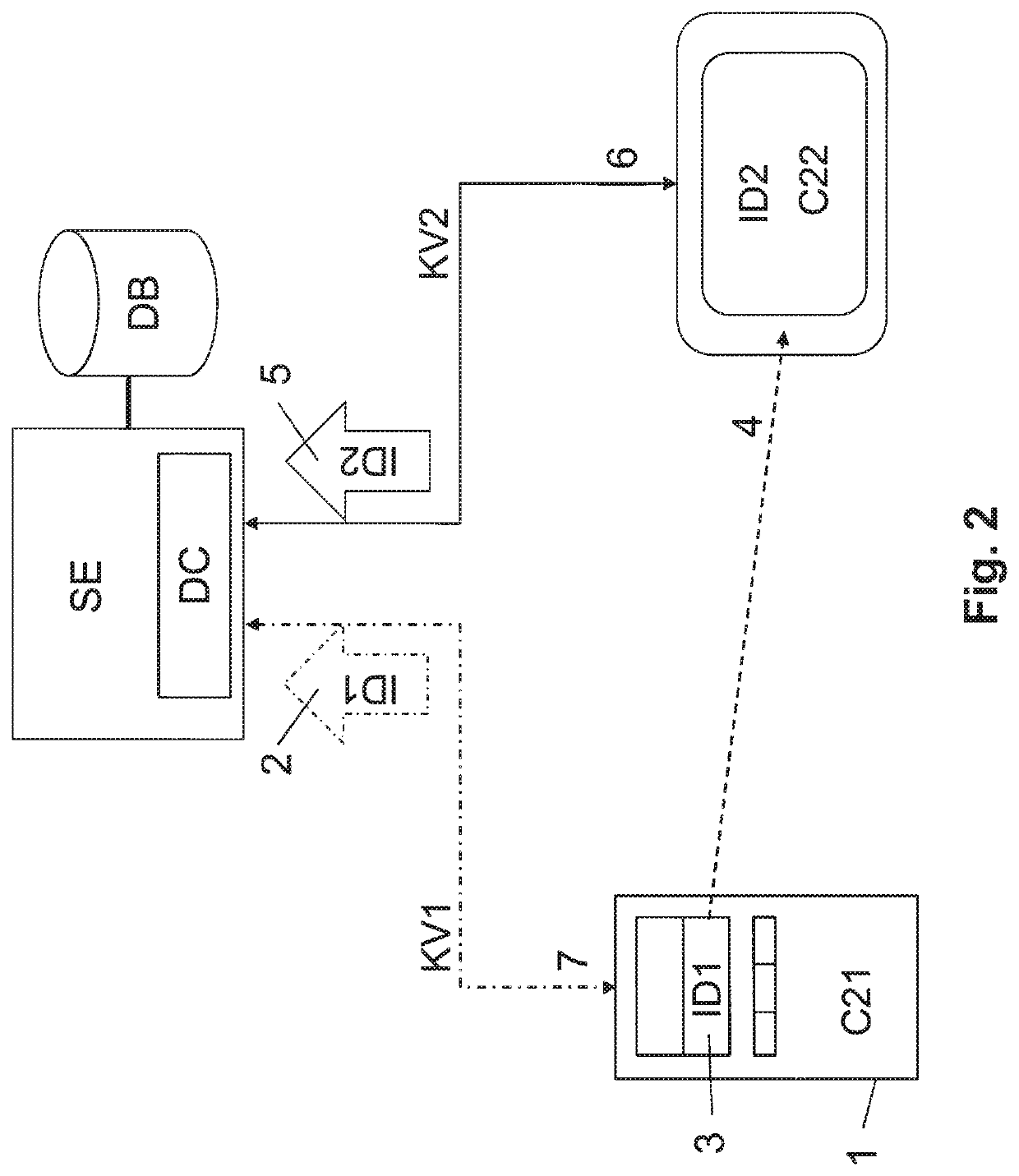[0010]The present invention is therefore presented with the task of specifying a method of the above-indicated type by which the disadvantages of the state-of-the-art can be avoided and by which, without any additional effort, amusement game sessions can be transferred with the respective current status and without interruption among the various terminal devices and / or client units within a server-based amusement game system.
[0016]It is advantageous if during the login and / or during the login process of the first client unit with the server unit—before the respectively current amusement game session has started—the identification of the first client unit is stored with the centrally stored, user-specific data. Normally, the utilization of a server-based amusement game system requires mostly a one-time registration where, depending on the respective legal, administrative and / or technical requirements, user-specific data, e.g. in form of a client card, a user account or user and / or player profile, are centrally stored in the amusement game system. These user-specific data can be advantageously stored e.g. in a central storage unit of the server unit or in a database attributed to a server unit. For using and / or establishing an amusement game session, the user must then for example log in and / or undergo a login process on the respective client unit. The user is required to enter, e.g. via a user interface of the respective client unit, user-specific login data to be processed to the server unit for purposes of matching with the respectively stored user-specific data. If the entered login data and the respective user-specific data match, a connection between the client unit and the server unit is established and an amusement game session can start. When transferring the login data to the server unit, it is possible to send along to the server unit—preferably in the background and / or without user interaction—the identification of the recently used client unit. When verifying the user data, the client unit identification can be easily stored with the user-specific data—e.g. in the user account or the user profile.
[0017]Throughout, it is advantageous to use a unique, device-specific identification for identifying the respective client unit. Depending on the utilized or used client unit, unique device-specific data, such as serial number, licensing number, operating number or unique hardware address can be entered as client unit for gaming terminals; or e.g. a so-called media access control or MAC address for e.g. wireless terminal devices such as smartphones, tablet PCs, laptops, etc. or, for PCs, as client unit. A MAC address is a hardware address that enables a communication or computer network to clearly identify a terminal device. Via the utilization of a unique, device-specific identification, the client unit can be clearly identified in the server-based amusement system, thus enabling clear identification by the server unit. The client unit can therefore be clearly addressed when communication is established or during the communication connection and the ongoing amusement game session.
[0020]It is appropriate that prior to deleting the identification of the first client unit from the user-specific data and prior to terminating the communication connection between the first client unit and the server unit, the user be prompted and / or required to confirm the switch to the second client unit. The user will thus be able to easily transfer the amusement game session currently running on the first client unit to the second client unit via confirmation; or to abort it. If the user does not enter a client unit switch confirmation and / or the amusement game session is aborted, the identification for the second client unit will once again be removed from the user-specific data. The identification of the first client unit remains stored with the user-specific data and the amusement game session is continued without interruption on the first client unit and at the current status.
[0021]It is advantageous if the identification of the respective client unit and / or the first client unit is displayed as so-called QR code, as barcode or as alphanumeric code. The representation as OR and / or Quick Response code or barcode makes it possible for the user—provided the second client unit has been set up this way—to enter the identification in the second client unit in a simple manner, e.g. via scanning or swiping. This avoids e.g. erroneous entries or typos, as can occur for alphanumeric codes. Especially QR codes provide a method for representing and / or displaying information so that they can be found very quickly by automation and read and / or displayed. The representation of the identification as alphanumeric code provides a flexible option for code entry since an alphanumeric code can usually be entered very easily via a user interface on the respective client unit. The client unit does not require special setup for inputting alphanumeric codes. It for example does not have to have a camera or sensor for detecting the code.
[0022]A server-based amusement game system can preferably integrate different terminal devices as client units. Gaming terminals, video lottery terminals, mobile terminal devices (e.g. smartphones, tablet PCs, laptops or PCs) can be used as client units in a simple manner. The respectively used client units can be offered for different uses of amusement games. Especially location-specific amusement game sessions e.g. in gaming venues or casinos can be established via gaming terminals, while mobile terminal devices can be used for wireless usage or laptops and / or PCs for online usage. Thanks to the method according to the invention, an amusement gaming session can be transferred without interruption and flawlessly e.g. from a gaming terminal to a wireless terminal device (e.g. smartphone) and from there to a personal computer. Likewise, a user may take an amusement gaming session e.g. from a wireless terminal device, into a casino, where it can be continued on a gaming terminal without losing the respectively current status.
 Login to View More
Login to View More  Login to View More
Login to View More 

